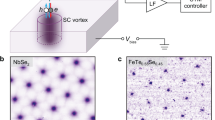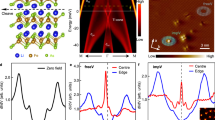Abstract
Several key experiments1,2,3 have revealed a rich variety of vortex structures in mesoscopic superconductors in which only a few quanta of magnetic flux are trapped: these structures are polygon-like vortex ‘molecules’ and multi-quanta giant vortices. Ginzburg–Landau calculations4 confirmed second-order phase transitions between the giant vortex states and stable molecule-like configurations5. Here we study theoretically the electronic structure and the related phase-coherent transport properties of such mesoscopic superconductor systems. The quasiparticle excitations in the vortices form coherent quantum-mechanical states that offer the possibility of controlling the phase-coherent transport through the sample by changing the number of trapped flux quanta and their configuration. The sample conductance measured in the direction of the applied magnetic field is determined by the transparency of multi-vortex configurations, which form a set of quantum channels. The transmission coefficient for each channel is controlled by multiple Andreev reflections within the vortex cores and at the sample edge. These interference phenomena result in a stepwise behaviour of the conductance as a function of the applied magnetic field, and we propose to exploit this effect to realize a vortex-based quantum switch where the magnetic field plays the role of the gate voltage.
This is a preview of subscription content, access via your institution
Access options
Subscribe to this journal
Receive 51 print issues and online access
$199.00 per year
only $3.90 per issue
Buy this article
- Purchase on Springer Link
- Instant access to full article PDF
Prices may be subject to local taxes which are calculated during checkout




Similar content being viewed by others
References
Boato, G. et al. Direct evidence for quantized flux threads in type II superconductors. Solid State Commun. 3, 173–176 (1965).
McLachlan, D. S. Quantum oscillations and the order of the phase charge in a low k type II superconducting microcylinder. Solid State Commun. 8, 1589–1593 (1970).
Geim, A. K. et al. Fine structure in magnetization of individual fluxoid states. Phys. Rev. Lett. 85, 1528–1531 (2000).
Schweigert, V. A., Peeters, F. M. & Deo, P. S. Vortex phase diagram for mesoscopic superconducting disks. Phys. Rev. Lett. 81, 2783–2786 (1998).
Chibotaru, L. F. et al. Symmetry-induced formation of antivortices in mesoscopic superconductors. Nature 408, 833–835 (2000).
Giaever, I. in Tunneling Phenomena in Solids (eds Burstein, E. & Lundqvist, S.) 255–271 (Plenum, New York, 1969).
Caroli, C., de Gennes, P. G. & Matricon, J. Bound fermion states on a vortex line in a type II superconductor. Phys. Lett. 9, 307–309 (1964).
Volovik, G. E. Vortex motion in Fermi superfluids and the Callan-Harvey effect. JETP Lett. 57, 244–246 (1993).
Tanaka, Y. et al. Energy spectrum of the quasiparticle in a quantum dot formed by a superconducting pair potential under a magnetic field. Solid State Commun. 85, 321–326 (1993).
Virtanen, S. M. M. & Salomaa, M. M. Multiquantum vortices in superconductors: Electronic and scanning tunneling microscopy spectra. Phys. Rev. B 60, 14581–14584 (1999).
Hess, H. F. et al. Scanning-tunneling-microscope observation of the Abrikosov flux lattice and the density of states near and inside a fluxoid. Phys. Rev. Lett. 62, 214–217 (1989).
Pincus, P. Magnetic-field-induced surface states in a pure type-I superconductor. Phys. Rev. B 158, 346–353 (1967).
Azbel’, M. Ya. & Blank, A. Ya. Magnetic surface levels in superconductors. JETP Lett. 10, 32–35 (1969).
Acknowledgements
We thank G. Crabtree, G. Karapetrov, A. Koshelev, V. Moshchalkov, D. A. Ryzhov, S. V. Sharov, I. A. Shereshevsky and I. D. Tokman for discussions. This work was supported by the US DOE Office of Science, a NATO Collaborative Linkage Grant, and by the Russian Foundation for Fundamental Research.
Author information
Authors and Affiliations
Corresponding author
Rights and permissions
About this article
Cite this article
Mel'nikov, A., Vinokur, V. Mesoscopic superconductor as a ballistic quantum switch. Nature 415, 60–62 (2002). https://doi.org/10.1038/415060a
Received:
Accepted:
Issue Date:
DOI: https://doi.org/10.1038/415060a
This article is cited by
-
Solution of the Landau–Ginzburg Equations Using Lattice–Boltzmann
Journal of Superconductivity and Novel Magnetism (2013)
Comments
By submitting a comment you agree to abide by our Terms and Community Guidelines. If you find something abusive or that does not comply with our terms or guidelines please flag it as inappropriate.



